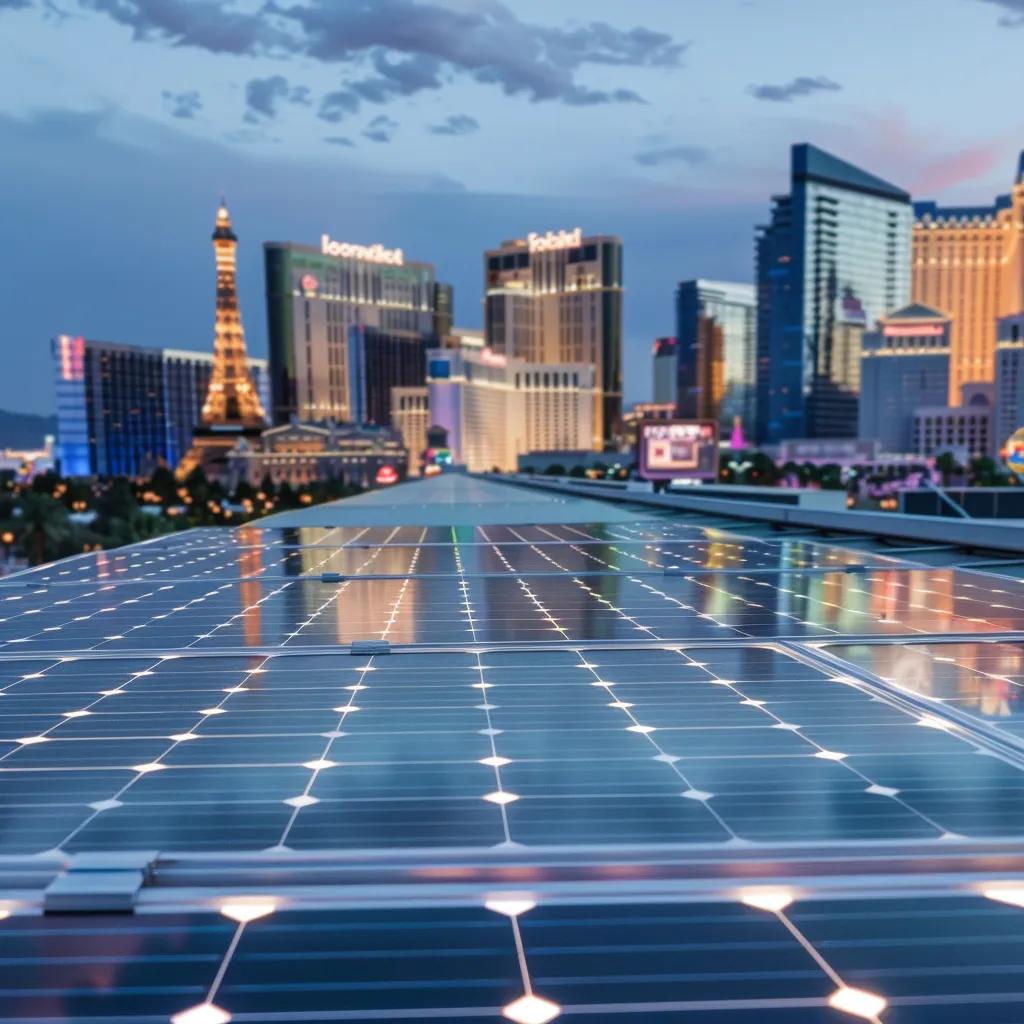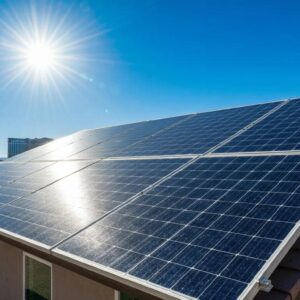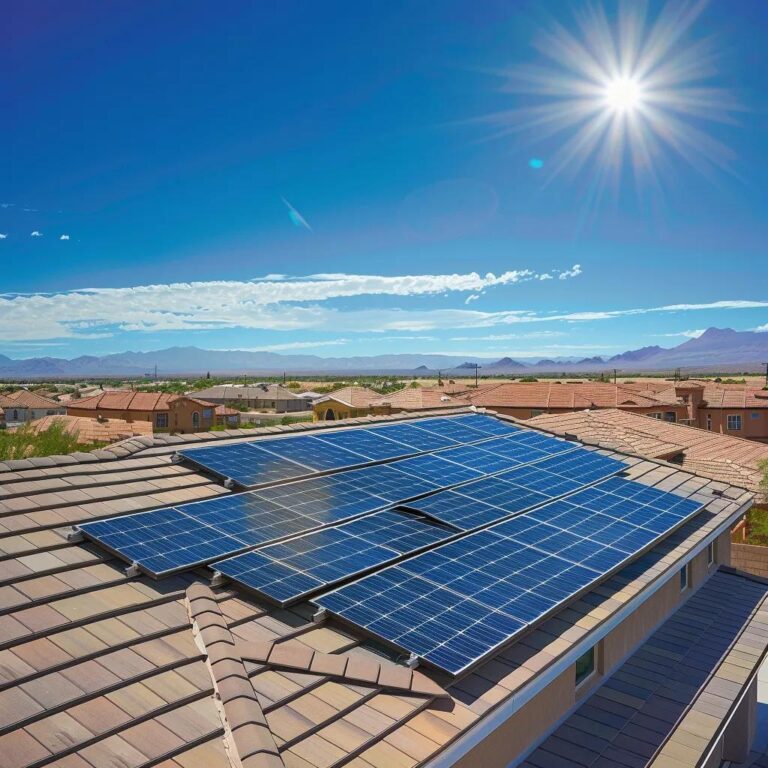Unlock Your Savings: Install a Solar Roof in Las Vegas and Boost Your Property Value!

Las Vegas homeowners and business owners can unlock up to 30 percent in federal tax credits while boosting property values by over 4 percent through strategic solar roof installation. By pairing state and local incentives with NV Energy’s net metering program, installing solar panels not only reduces upfront costs but also elevates real estate appeal. This article explains how solar installations deliver substantial tax savings, enhance home and commercial property values, optimize energy credits, outline average costs and financing options, detail business-specific advantages, and demonstrate environmental and independence benefits in the Las Vegas climate.
What Are the Key Tax Savings from Solar Roof Installation in Las Vegas?

Claiming solar incentives dramatically lowers the net investment in renewable energy systems. Nevada residents benefit from the Federal Solar Investment Tax Credit (ITC), state rebates, sales tax exemptions, and Renewable Energy Tax Abatement (RETA). Understanding each mechanism ensures maximum cost reduction.
How Does the Federal Solar Investment Tax Credit (ITC) Work in Nevada?
The Federal Solar ITC provides a 30 percent credit on the total cost of a qualifying solar installation through 2032. It applies to residential and commercial systems, including paired battery storage solutions like Tesla Powerwall. By reducing the tax liability dollar for dollar, the ITC lowers a $20,000 system cost to $14,000, making renewable energy more accessible.
Federal Solar Investment Tax Credit (ITC)
The Federal Solar Investment Tax Credit (ITC) offers a significant financial incentive for homeowners and businesses investing in solar energy systems. This credit reduces the tax liability of the system owner, making renewable energy more accessible and affordable.
U.S. Department of Energy, “Federal Tax Credits for Renewable Energy” (2024)
This source provides official information on the ITC, which directly supports the article’s claims about tax savings.
What State and Local Solar Incentives Are Available in Nevada?
Nevada’s incentives include a full sales tax exemption on solar equipment, local utility rebates up to $600 per kilowatt, and RETA benefits for commercial installations. An overview of key state and local incentives:
| Entity | Attribute | Value |
|---|---|---|
| Nevada Sales Tax Exemption | Tax Exclusion | 100 percent on solar panels and inverters |
| Local Utility Rebate | Rebate Amount | $300–$600 per kW installed |
| Renewable Energy Tax Abatement | Sales & Use Tax Exemption | Up to 100 percent for 3 years (commercial) |
| Property Tax Reduction | Up to 55 percent for 20 years (commercial) |
State and local benefits layer on federal credits to shrink net system costs and accelerate return on investment.
Who Qualifies for Solar Tax Credits and Incentives in Las Vegas?
Any Nevada homeowner or business that installs a grid-tied photovoltaic system meets basic criteria. Qualifying requirements include:
- System Ownership: The taxpayer must own rather than lease the solar array.
- Certified Equipment: Panels and inverters must meet UL or IEC standards.
- Installation Date: System must be placed in service between January 1, 2022, and December 31, 2032, for full ITC eligibility.
Meeting these standards unlocks federal, state, and local savings that reduce net present costs by as much as 40 percent.
How Do Solar Tax Savings Reduce the Overall Installation Cost?
Combining the ITC with state and local rebates can cut a typical Las Vegas system cost by up to $8,000 on a 6 kW installation. A breakdown illustrates net cost impact:
- Gross Cost (6 kW system): $15,000
- Federal ITC (30 percent): –$4,500
- Local Rebate (600 $/kW): –$3,600
- Net Sales Tax Savings (85 percent VAT effect): –$450
- Out-of-Pocket Cost: $6,450
This layered approach empowers more homeowners to invest in clean energy with less financial burden.
What Are the Steps to Claim Solar Tax Credits and Incentives?
Securing incentives involves a straightforward application and documentation process:
- Gather Invoices: Collect detailed equipment and installation receipts.
- Complete IRS Form 5695: Attach with your annual individual tax return for the ITC.
- Submit Local Rebate Forms: Provide proof of purchase and system specs to your utility.
- Apply for RETA (Commercial Only): File with the Nevada Governor’s Office of Economic Development for tax abatement approval.
Carefully following these steps ensures timely receipt of each monetary benefit and further reduces the effective system price.
How Does Solar Roof Installation Increase Home and Commercial Property Value in Las Vegas?

Solar panels deliver tangible market advantages by enhancing curb appeal, lowering utility costs for buyers, and signaling environmental stewardship. Owned systems integrate as property assets, translating to measurable value gains.
By How Much Can Solar Panels Increase Home Value in Las Vegas?
Studies show owned photovoltaic systems add approximately 4.1 percent to a home’s sale price. In Las Vegas’s median home market of $350,000, this equates to:
- Increase Percentage: 4.1 percent
- Approximate Value Gain: $14,350
Impact of Solar Panels on Home Value
Studies indicate that the installation of solar panels can increase a home’s value, making it more attractive to potential buyers. This increase reflects the growing demand for energy-efficient homes and the long-term cost savings associated with solar energy.
National Renewable Energy Laboratory, “The Value of Solar Homes” (2022)
This citation supports the article’s claims regarding the increase in home value due to solar panel installation.
What Factors Influence Solar’s Impact on Real Estate Value?
Solar’s value contribution depends on:
- Ownership Status: Owned systems transfer value; leased arrays may complicate mortgages.
- System Age and Condition: Warranty status and remaining output performance guarantee influence appraisal.
- Local Market Trends: Eco-friendly neighborhoods tend to reward renewable investments more generously.
A modern, well-maintained system with transferable warranties can command higher premiums and expedite sales.
How Do Owned Solar Systems Compare to Leased or PPA Systems in Resale Value?
Owned systems directly enhance equity, while leased or power purchase agreement (PPA) arrangements may:
- Require contract novation for a new buyer
- Present additional credit checks or transfer fees
As a result, leased systems can reduce market appeal despite monthly savings. Ownership ensures value retention and seamless transferability.
Why Are Solar Homes More Attractive to Eco-Conscious Buyers?
Energy-efficient homes with rooftop solar appeal to buyers prioritizing lower carbon footprints and cost certainty. A green certification or “solar-ready” branding can shorten listing times and spark competitive offers.
What Are Real Las Vegas Case Studies Showing Solar’s Effect on Property Value?
Local examples confirm these trends:
| Property Type | System Size | Value Increase | Buyer Feedback |
|---|---|---|---|
| Single-Family Home | 5 kW | 5 percent | “Loved the guaranteed monthly savings.” |
| Townhouse Community | 3 kW | 3.8 percent | “Solar was a top selling feature.” |
| Commercial Office | 50 kW | 6 percent | “Reduced operating costs impressed us.” |
These real-world outcomes underline solar’s role as a strategic investment in property marketability and total return.
What Is NV Energy’s Net Metering Program and How Does It Benefit Solar Customers?
NV Energy’s net metering framework credits excess solar generation at 75 percent of retail rates (Tier 4), rolling unused credits forward indefinitely. This system transforms rooftop arrays into virtual batteries that offset future bills.
How Does Tier 4 Net Metering Work for New Solar Installations?
Tier 4 grants a 0.75x multiplier on every kilowatt-hour exported to the grid. When panels produce surplus, that energy converts into credits applied against subsequent consumption. By leveraging this rollover policy, customers maximize lifetime savings without seasonal credit expirations.
How Are Monthly Energy Credits Calculated and Applied?
Credits accumulate whenever generation exceeds onsite demand and apply during periods of higher consumption. At year-end, any remaining balance carries over to the next billing cycle. This true-up billing model ensures solar power is fully monetized throughout the year.
What Is the Application Process for NV Energy Net Metering?
Enrollment steps include:
- System Sizing Approval: Submit proposed array specifications for utility review.
- Interconnection Agreement: Sign contract outlining metering and credit terms.
- Inspection and Meter Swap: NV Energy installs a bi-directional meter post-inspection.
Completing these stages connects your system to the grid under net metering terms.
How Does Net Metering Affect Solar Payback Period and Savings?
By capturing value for every kilowatt-hour exported, net metering can shorten typical payback periods by 1–2 years. A 7–10-year ROI estimate in Las Vegas can compress to 6–8 years when Tier 4 credits are fully utilized.
What Are the Average Costs and Financing Options for Solar Roof Installation in Las Vegas?
Understanding local pricing and payment solutions enables informed decisions. System costs vary by size, equipment tier, and installer expertise, while financing structures cater to a range of budgets.
What Is the Average Cost per Watt and Total System Price in Las Vegas?
Current market data shows:
- Average Cost/Watt: $2.17–$2.85
- Typical Residential System (6 kW): $13,020–$17,100 before incentives
Competitive proposals from certified installers like Sol-Up often fall near the industry median, ensuring quality at fair rates.
Which Factors Affect Solar Installation Costs Locally?
Key cost drivers include:
- Equipment Quality: Tier 1 panels and premium inverters command higher upfront prices but yield stronger warranties.
- Installation Complexity: Roof pitch, shading analysis, and structural upgrades influence labor.
- System Size: Larger arrays benefit from economies of scale per watt.
Selecting trusted, NABCEP-certified professionals helps control surprises and ensures long-term performance.
What Financing Options Are Available for Solar in Las Vegas?
Homeowners can choose from:
- Cash Purchase: Maximizes incentives and ROI, lowest lifetime cost.
- Solar Loans: Low-interest, secured or unsecured loans with fixed payments.
- Leases & Power Purchase Agreements: No-money-down options with monthly payments or per-kWh charges (no tax credit eligibility).
Comparing total cost, incentives, and ownership impacts clarifies the optimal funding path.
How Is the Solar Payback Period Calculated in Nevada?
Payback equals net system cost divided by annual electricity bill savings. For a 6 kW array yielding $1,200 in yearly savings after credits:
- Net Cost: $6,450
- Annual Savings: $1,200
- Payback Period: 5.4 years
Incorporating net metering and escalating utility rates may accelerate this timeline.
How Do Tax Credits and Incentives Influence Final Solar Costs?
Applying the Federal ITC, sales tax exemption, and local rebates can slash gross system prices by 40 percent or more. Detailed modeling ensures each incentive is captured to minimize out-of-pocket investment.
What Are the Unique Benefits of Commercial Solar Roof Installation in Nevada?
Businesses in Las Vegas face rising energy expenses and tax obligations. Commercial solar arrays deliver direct cost reductions, accelerated depreciation, and multi-year tax abatements that boost corporate bottom lines.
How Does the Renewable Energy Tax Abatement (RETA) Support Commercial Solar?
RETA offers:
- Sales & Use Tax Exemption: Up to 100 percent on solar equipment for three years.
- Property Tax Reduction: Up to 55 percent abatement on assessed value for 20 years.
These benefits complement federal ITC and bonus depreciation, significantly enhancing project returns.
What Is the ROI for Commercial Solar Projects in Las Vegas?
A 100 kW rooftop system costing $200,000 pre-incentives can yield:
| Entity | Attribute | Value |
|---|---|---|
| Federal ITC | Credit Percentage | 30 percent ($60,000) |
| RETA Sales Tax | Savings | $16,000 (8 percent rate) |
| Property Tax Abatement | Value Reduction | $12,100 annually |
| Accelerated Depreciation | First-Year Benefit | $40,000 |
| Net Investment | Total After Credits | $64,000 |
| Payback Period | After Incentives | 2–3 years |
This rapid ROI aligns with corporate sustainability and financial goals.
How Do Large-Scale Solar Installations Benefit Nevada Businesses?
Beyond tax savings, businesses gain:
- Stable Energy Pricing: Long-term hedge against utility rate inflation.
- Corporate Social Responsibility: Enhanced brand image and stakeholder appeal.
- Energy Independence: Reduced grid reliance during peak demand.
Such outcomes translate to measurable value in financial reports and community relations.
What Are the Eligibility Requirements for Commercial Solar Incentives?
Commercial projects must satisfy:
- Minimum System Size: Generally above 10 kW for RETA eligibility.
- Local Jurisdiction Approval: Building permits and interconnection agreements.
- Tax Status: Businesses must be liable for Nevada sales and property tax to benefit.
Meeting these criteria unlocks powerful savings and accelerates project viability.
How Does Solar Roof Installation Contribute to Environmental and Energy Independence Goals in Las Vegas?
Rooftop solar reduces greenhouse gas emissions while enabling resilience against grid disruptions. The abundant desert sunshine and supportive policy environment make Las Vegas ideal for both environmental and autonomy objectives.
How Does Solar Reduce Carbon Footprint and Greenhouse Gas Emissions?
Every installed kilowatt of solar capacity prevents roughly 0.85 metric tons of CO₂ annually by displacing fossil-fuel energy. A typical 6 kW system therefore avoids:
- Annual CO₂ Reduction: 5.1 metric tons
This aligns with broader sustainability commitments at both household and corporate levels.
What Role Does Battery Storage Play in Energy Independence?
Pairing solar with a battery bank like Tesla Powerwall grants:
- Backup Power: Continuous operation during outages.
- Peak Shaving: Discharging stored energy at high-rate periods to lower bills.
- Grid Relief: Reducing stress on local distribution networks.
Energy independence rises as critical loads remain powered by onsite generation and storage.
Why Is Las Vegas an Ideal Location for Solar Energy?
Key environmental advantages include:
- High Insolation: Over 300 sunny days per year maximize generation.
- Flat Roof Profiles: Widespread suitability for panel arrays.
- Supportive Policies: State and utility incentives that reward investment.
These factors combine to yield higher capacity factors and attractive project economics.
How Do Solar Customers Gain Independence from Volatile Energy Markets?
Locking in energy production at fixed system costs insulates owners from:
- Utility Rate Hikes: Annual escalators of 3–5 percent average.
- Seasonal Spikes: Summer peak charges during extreme heat events.
- Regulatory Shifts: Future grid cost allocations and carbon fees.
Solar owners secure predictable energy budgets and gain strategic autonomy.
What Are Common Questions About Solar Roof Installation Benefits in Las Vegas?
Homeowners and businesses frequently ask how savings translate into real dollars, what net metering rates apply, and whether solar truly pays off in the desert heat. The answers below clarify these top concerns.
How Much Can I Save on Taxes with Solar in Las Vegas?
Homeowners qualify for a 30 percent Federal ITC and local rebates up to $3,600 on a 6 kW system, reducing tax liability by over $8,000. Commercial arrays also leverage Nevada’s RETA for sales and property tax relief, amplifying total savings.
Does Solar Increase Home Value in Las Vegas?
Yes, owned solar systems can boost home sale prices by approximately 4.1 percent, translating to a $14,350 increase on a $350,000 property. Buyers recognize lower utility bills and sustainable features as premium assets.
What Is NV Energy’s Net Metering Rate for Solar Customers?
New residential installations in Tier 4 receive credits at 75 percent of the retail electricity rate for each kilowatt-hour exported. Unused credits roll over indefinitely, ensuring full value capture.
Is Solar Worth the Investment in Las Vegas?
Solar systems in Las Vegas typically pay for themselves within 6–8 years after incentives, with expected lifespans of 25+ years. Long-term energy bill avoidance and property appreciation make solar a sound financial and environmental choice.
How Do Leased Solar Systems Affect Home Resale?
Leased arrays may require contract transfers and additional buyer credit checks, potentially complicating closings. Owned systems avoid these hurdles and guarantee seamless equity transfer.
Homeowners and businesses in Nevada, California, and Idaho seeking to reduce energy costs and embrace sustainable solutions can rely on Sol-Up’s engineering expertise, NABCEP-certified teams, and strategic partnerships to design efficient, high-value solar roof installations. Contact a Sol-Up specialist today to explore custom proposals, solar-plus-storage options, and detailed financial analyses tailored to your property’s needs.
Ready to Save Money and Go Green?
Don’t miss out on the incredible savings and benefits of solar energy. Get a personalized quote today and start your journey to energy independence!
Conclusion
Investing in solar roof installation in Las Vegas not only unlocks significant tax savings but also enhances property values, making it a smart financial decision for homeowners and businesses alike. By leveraging federal, state, and local incentives, you can maximize your return on investment while contributing to a sustainable future. Take the next step towards energy independence and financial savings by exploring our tailored solar solutions. Contact a Sol-Up specialist today to discover how we can help you harness the power of solar energy for your property.






